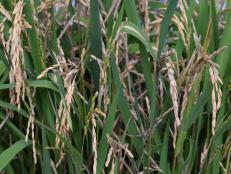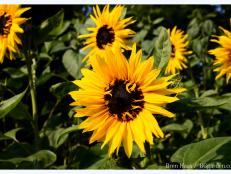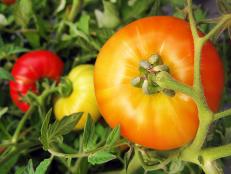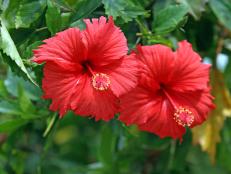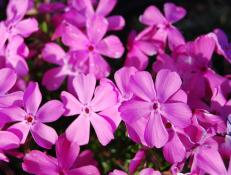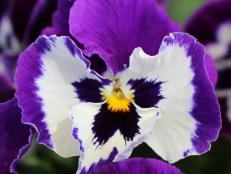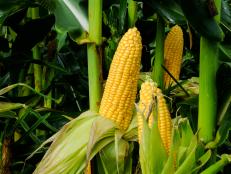How to Plant, Grow and Care for a Fig Tree
Big on taste and good looks, fig trees ripen candy-like fruit on a plant packed with textural appeal. Best of all, this edible beauty is surprisingly easy to grow.

Figs don't just come tucked inside a cookie. These sweet fruits form on a tree or shrub that's as eye-catching as it is easy to grow. While other edible crops might need pampering to yield their bounty, figs are more of a plant-it-and-forget-it addition to your landscape.
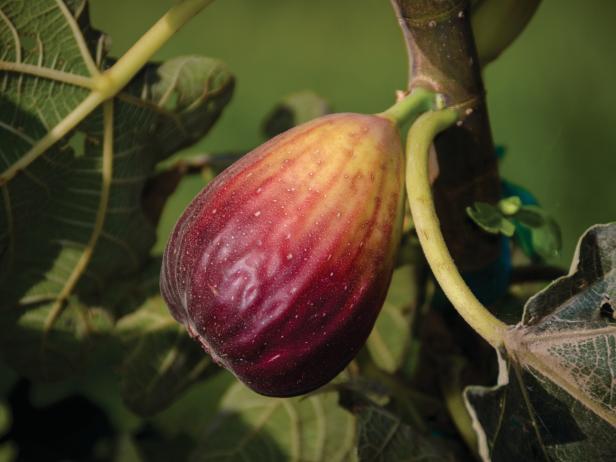
W. Atlee Burpee & Co.
With their unassuming personality, figs make a terrific choice for edible gardening. They blend easily into shrub borders, flower beds or vegetable gardens and also grow well in containers. Enhance your success with figs by following these simple tips.
Finding the Right Variety
Native to Asia Minor and the Mediterranean, figs are landscape fixtures in warmer regions (zones 8 and warmer), where they can grow unprotected year-round. They can grow well in areas with some cold snaps (zone 7), and you can also find varieties that grow and bear fruit in areas (zones 6 and colder) where winter dishes out snowstorms and freezing temps for weeks on end. Most winter-hardy varieties do need some kind of cold weather protection to ensure strong fruit production.
Fig trees come in two forms: potted and bareroot. If you order from a fruit tree nursery, you're more likely to find bareroot saplings. At many nurseries and home centers, potted figs are the norm. Most varieties will grow well in zones 7 and above; for colder areas, try these suggestions:
- For Zone 6 winters, consider these varieties: 'Michurinska 10' (developed in Bulgaria), 'Celeste' or 'Marseilles.'
- For Zone 5 winters, try these varieties: 'Chicago Hardy,' 'Brunswick' (also known as magnolia fig) or 'Brown Turkey' fig (sugar fig).

Julie Martens Forney
'Chicago Hardy' fig is a variety that’s winter-hardy to Zone 5. Unripe figs are hard and green. As figs ripen, color shifts to deep brown-purple and fruit becomes softer to the touch.
If you're tucking your fig into a pot, focus on varieties developed for container growing, such as 'Brown Turkey,' 'Blanche' (Italian honey fig), 'Celeste,' 'Verte,' 'Negronne' (also known as 'Violette de Bordeaux') or 'Ventura.'
Choosing a Planting Spot
Figs need two things to thrive: sunshine and elbow room. Select a spot that provides at least six hours of sun daily. In colder regions, help figs survive winter by giving them a southern exposure or placing them near a south-facing wall that will retain heat.
Double-check your fig variety's mature size and give it plenty of room to spread. Figs are self-pollinating, so you don't need multiple plants to get fruit— but you do need to avoid crowding plants if you're adding more than one to your yard.
Some fig varieties have invasive roots that may damage pipes, sidewalks or driveways. Be sure to research this before planting your fig, especially in warmer regions where plants grow more aggressively. Tuck your fig into a spot on the edge of a garden to give its roots room to roam.
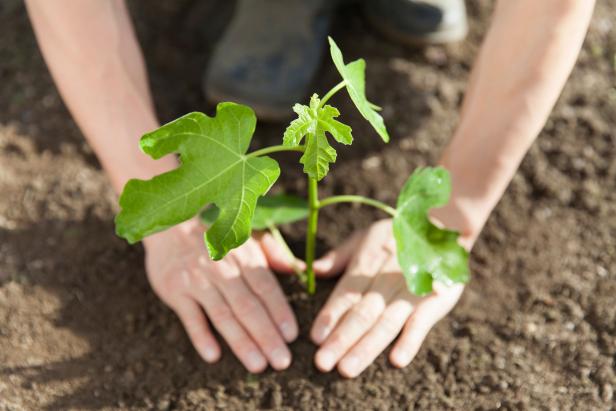
Shutterstock/Alexander Knyazhinsky
When planting a fig tree, choose a spot with plenty of sunshine and good air flow. Add organic matter to soil to create a foundation that will keep your fig happy for years to come.
Planting a Fig Tree
The best time of year to plant a fig is early spring. In colder regions, wait until all danger of frost has passed. Spring planting gives your heat-loving fig a chance to sink roots and unfurl leaves during the current growing season. It is also okay to plant figs in the fall. In regions with hard frosts, try to get your fig into the ground about six weeks before the ground freezes (sooner is better).
Remove your fig carefully from its pot. You might have to lay the pot on its side and press slightly on the pot to loosen the root ball. Gently grab the stems and slide the plant out of the pot, or turn it upside down. Place your fig in the planting hole at the same depth it was planted in the pot.
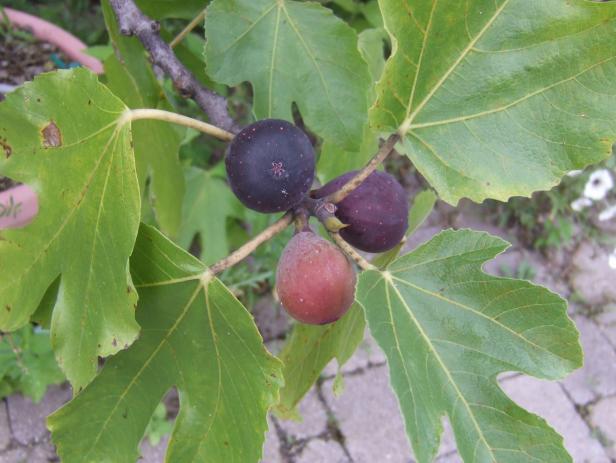
Julie Martens Forney
Dark-skinned figs change color as they ripen, with a deeper hue giving one clue to ripeness. This fig variety is ‘Negronne,’ which is also known as ‘Violette du Bordeaux.’ It’s a good fig for containers.
If you're planting a bareroot fig, follow the instructions that come with it. A bareroot tree needs moisture; don't let it sit in an unopened box overnight. Unpack the tree carefully, and hose off any material clinging to the roots. Soak roots in a bucket of water for an hour or two before planting. Dig a hole a few inches deeper than the roots and at least as wide as the roots when fanned out. Place the tree in the hole and spread out the roots. Position the point of the trunk where the roots begin to spread out just below the soil line.
When planting potted or bareroot figs, after settling your fig in the planting hole, backfill with soil until the hole is three-quarters full. Water well to settle soil. Finish filling the hole and water again.
Soil, Food and Water
Give your fig a good start by adding composted manure or well-rotted compost to the planting area. On the whole, figs don't have large appetites. Spreading a layer of compost (2 to 3 inches thick) over mulch beneath the fig in spring should provide sufficient nutrients for a healthy plant, or use a slow-release fertilizer with a low first number (nitrogen). Organic fertilizer that's fish- or poultry-based works well. If you prepare the planting hole with compost, you shouldn't need to fertilize your fig again until the following spring.
In their native environment, figs survive on rainfall. Make sure newly planted figs receive consistent moisture during the first year. If soil dries out in summer heat or drought, water the tree well. The most critical time that figs need water is in early spring, just before stems start shooting and fruits begin to form. On the whole, though, established in-ground figs don't usually need watering except during times of drought.
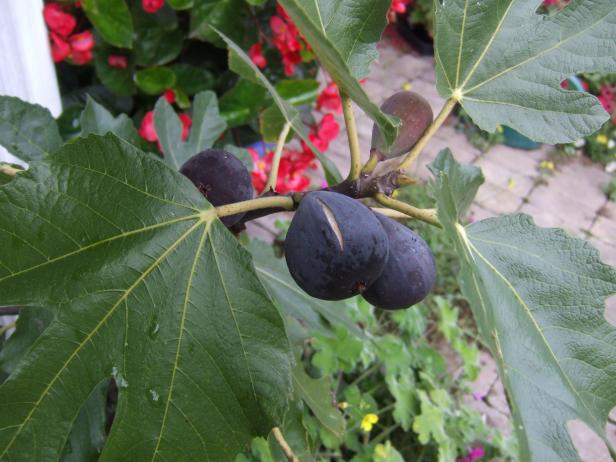
Julie Martens Forney
Like tomatoes, nearly ripe figs can split (see photo above) if they receive a sudden burst of water, like a summer thunderstorm. This occurs with figs grown in-ground or in containers, although potted plants are more susceptible. Aim to water figs in containers to achieve consistent soil moisture and avoid severe soil drying.
Harvesting Figs
Some varieties produce one crop of figs each year, while others produce two. Figs typically form on new stem growth each year and ripen months later. Most fig trees take three to five years to start ripening fruit. Prior to that, figs may form along stems where each leaf attaches, but they won't ripen. Potted figs may bear fruit sooner.
Unripe figs are green, firm and perpendicular to the branch. As a fig ripens, it changes color (look up what color your figs should be when ripe, depending on the variety) and softens. The telltale sign of a ripe fig is when the fruit droops down from the branch.
If you pick figs too early, they'll be hard, grainy and lack sweetness. A fully ripe fig is a tasty treat — sweet and juicy. Figs don't ripen more once you pick them, so you want to get this right. Wait a day if you're unsure. When picking, pinch or use a knife to cut the fruit stem (green part) between the fig and the woody branch. Figs typically store up to three days in the fridge, but they won't last that long if you break off the fruit stem.
As fruit starts to ripen, it's a good idea to cover plants with bird netting or install shiny scare tape. Otherwise, you'll lose much of your crop to birds, squirrels and their critter pals.
If your plant isn't producing figs, it might be due to too much fertilizer, extreme heat or drought, crowded branches or not enough sunlight. It might also be that you've planted a variety that needs a longer season to ripen than what your growing zone provides.
Pruning Figs
Typically figs only need pruning during the first few years, when you want to train the plant as a shrub, tree or espalier. It's safe to prune at any point in the growing season, although spring pruning can lead to larger fruits. Remove dead wood or branches that rub. Shorten branches that become too tall, removing one-third to one-half of the entire stem. Figs have milky, latex-like sap that can cause skin irritation, so wear non-porous gloves when pruning.
In cold-winter regions, if figs die to the ground, spring pruning can stimulate new growth. Determine if existing stems are alive by scraping the bark with a fingernail. Living stems show green; brown or gray means a stem is dead.
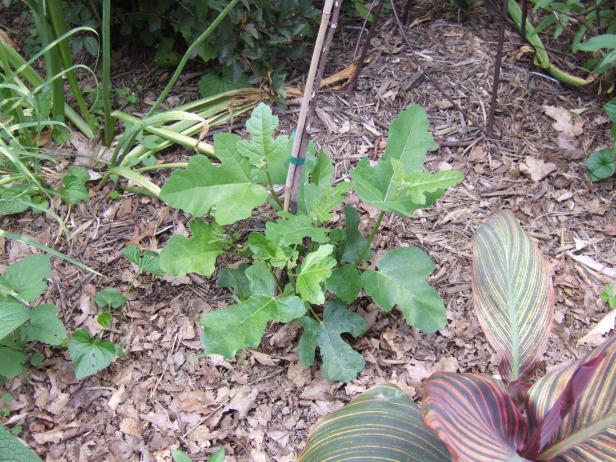
Julie Martens Forney
Hardy figs like ‘Chicago Hardy’ sometimes die to the ground during a hard winter. Before thinking your plant is dead, in spring wait and watch for new growth that emerges directly from the base of the plant.
New stems grow from the roots each spring. Let stems grow roughly 12 inches tall, and then thin to leave 10 to 12 stems. Remove the thinnest ones and any that are touching or rubbing. Figs need good air circulation inside the plant. Removing stems helps accomplish this and also helps yield higher-quality figs.
Providing Winter Protection
Figs need TLC to overwinter in colder regions to prevent winter-kill on aboveground stems. New stems grow from roots in spring, but these won't bear a strong crop for two to three years. In colder zones, if you want a healthy fig crop, it's a good idea to protect stems in winter.
Shrub-type figs are easier to protect than ones pruned to tree form. You can bend pliable branches to the ground, pin them using landscape staples and cover with leaves and a tarp or old blanket. Or, tie branches upright together and wrap with burlap or old blankets. Add leaves or straw to help insulate the fig.
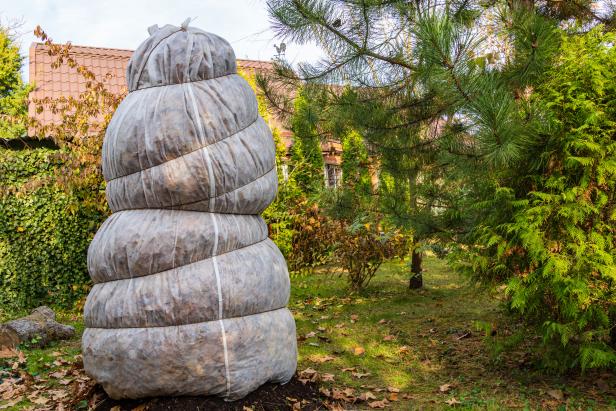
Shutterstock/Alexander Denisenko
Winter-hardy fig trees are typically hardy to Zone 5. In coldest parts of Zone 5, these figs need winter protection to help ensure a fruit crop during the next growing season. The easiest way to provide winter protection is to tie branches together and wrap the tree with a spunbond frost protection fabric stuffed with autumn leaves.
Another option is to place a chicken wire cage around your fig (tie the branches up together to fit). Once the ground freezes, fill the chicken wire with leaves or straw. Add a tarp to shed rain. Professional growers suggest placing a block or two of rodenticide on the ground before adding insulating leaves or straw. Otherwise, voles may devour fig stems over winter.
If you're growing potted figs, shift containers into a garage or cool basement for winter. Barely water plants (maybe every 4 to 6 weeks) — just enough to keep roots alive. Shift pots outdoors in spring when all danger of frost has passed.

.-Battle-on-the-Beach-courtesy-of-HGTV.-.jpg.rend.hgtvcom.196.196.suffix/1714761529029.jpeg)






